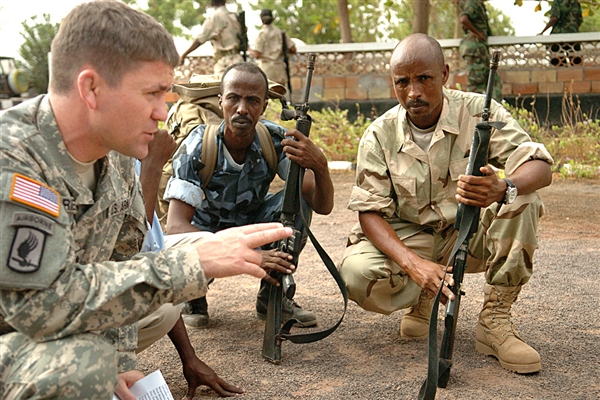Mel Gurtov
Welcoming the leaders of Finland and Sweden to Washington on May 19, President Biden said that “what makes NATO strong isn’t just our enormous military capacity, but our commitment to each other, to its values. NATO is an alliance of choice, not coercion.” NATO is indeed a growing alliance; once Finland and Sweden are officially members, the alliance will count 32 countries. As Vladimir Putin has discovered, making war on Ukraine has strengthened rather than weakened both NATO and the 27-member European Union (EU). But will that unity last?
Some European leaders have struck a cautionary note. Poland’s prime minister, for instance, said recently: “Putin is counting on the fatigue of the West. He knows that he has much more time because democracies are less patient than autocracies,” repeating what Xi Jinping said to Biden shortly after Biden took office. There’s something to that warning, because despite appearances and concrete cooperation, the alliance is not entirely of one mind on at least three issues: energy, food, and the way forward on Ukraine.
Ending Energy Dependence on Russia
Europe’s reliance on Russia for energy has been a dilemma anticipated for some time. The European Union imported nearly 100 billion euros ($110 billion) worth of Russian energy last year. Russia supplies about 40 percent of the bloc’s imports of natural gas, about 27 percent of its imported oil, and about 46 percent of its coal. How to shrink that dependence is causing deep anxiety in European capitals.
Sanctioning Russian oil and gas is clearly not a popular subject in NATO and the EU. Energy is obviously central to all economies, and a willingness to sacrifice on economic growth varies considerably among alliance members. People think China is the wild card when it comes to keeping Russia afloat, but Turkey and Hungary are better candidates. The EU reached a watered-down agreement on Russian oil imports at the end of May that exempts one pipeline that goes through Hungary from sanctions, reflecting Victor Orbán’s refusal to support a total ban on Russian oil imports by the end of 2022. Orbán points to Hungary’s dependence on Russia for energy in general, including nuclear power, but in fact he is a Putin admirer, demonstrated not just by his repressive politics but also by his refusal to allow weapons to be shipped from Hungary to Ukraine. Still, led by Germany and Poland, the EU by year’s end will have eliminated all but about 10 percent of Russian oil imports.
EU solidarity is also being tested when it comes to Russian gas exports. Germany, dependent on Russia for about 55 percent of its gas imports, may fall into recession if Russia cuts its exports entirely. Moscow has just cut those exports in half. Vulnerability to Russia is nearly as high elsewhere in Europe, raising anxieties about an energy crisis when winter comes—probably just as Putin hopes will happen. Several countries—Finland, Netherlands, Poland, and Bulgaria—have refused to pay Russia in rubles and have already had their gas cut off by Gazprom. And Serbia, which has not joined in sanctions against Russia and is seeking to join the EU, shocked the alliance by concluding a three-year gas deal with Gazprom just as the oil embargo was agreed upon. That act raises a question: Why should Ukraine’s application for EU membership be delayed when countries like Serbia and Hungary impede common action?
Food Warfare
Food supplies present a second difficult problem for the alliance, and for the world. Russia and Ukraine supply about a third of the world’s wheat, but Russia has blockaded the Black Sea to prevent Ukraine from exporting grain. Zelensky is pleading with the UN and Europe to get Russia to release a huge stock of Ukrainian wheat and other farm products—22 million tons, he says. Putin’s food warfare, which now includes apparently targeted attacks on Ukraine grain terminals and railway lines, is unlikely to change. The strategy, evidently intended to force a relaxation of sanctions on Russia, threatens the global food chain, which is already stressed by climate change and rising fuel, fertilizer, and shipping costs. Climate change has brought prolonged drought and mega-heat to food-deficit regions such as East Africa and the Indian subcontinent. The World Food Program reports that 89 million people are now considered “acutely food insecure” in East Africa alone, particularly in Somalia, where widespread starvation is imminent. Putin, of course, blames the West for the food crisis in the same way that he blames NATO for the war.
On May 19, the CEO of the agricultural analytical company Gro Intelligence, Sarah Menker, testified before the UN Security Council that the world has only 10 weeks of stored wheat reserves left in warehouses. The UN Food and Agriculture Organization published one estimate that 49 million people are at risk of famine in coming months, and 750,000 people face starvation right now. Putin, in a major speech in St. Petersburg on June 17, disclaimed any responsibility for the food shortages and denied blockading Ukraine’s Black Sea ports, saying: “They [the Ukrainians] can clear the mines and resume food exports. We will ensure the safe navigation of civilian vessels. No problem.” He pledged a major increase in Russian food exports to the neediest regions.
Turkey, which is playing both sides in the war—providing drones to Ukraine but refusing to sanction Russia and holding Finland’s and Sweden’s applications to join NATO hostage to their protection so far of anti-Erdogan Kurds—is in talks with Putin to allow Turkish vessels to exit the Black Sea with Ukraine grain. If Putin doesn’t follow through on his promise of safe navigation, some observers are favoring a military effort to break the Russian blockade in the Black Sea. Ukraine does not have the weapons to deter the Russia fleet, and aside from Denmark, which has promised to provide Ukraine with a Harpoon coastal missile battery, NATO has not moved on the idea. James Stavridis, a former NATO commanding general, has proposed a NATO- or US-led convoy to free the Ukraine ships. But he admits that such a mission would be high-risk and very unlikely to received NATO’s or the US’s endorsement.
Ending the War
Bringing this war to an end is surely the most challenging issue for the alliance. Various parties—the French, the UN, the Turks, the Hungarians—have taken a crack at urging Putin to engage with Zelensky, to no avail. Once a stalemate occurs on the battlefield, Zelensky will have difficult choices, especially about surrendering territory, and within NATO those choices will have their separate supporters. Ending or softening sanctions on Russia, redeploying military units, creating a durable ceasefire, reopening sea lanes, compensating Ukraine for its enormous losses—these will all have to be ingredients, not necessarily for a negotiated settlement (since not all wars end in agreement) but for the carnage simply to stop. It doesn’t help to have President Emmanuel Macron of France declare: “We must not humiliate Russia so that the day the fighting stops, we can build a way out through diplomatic channels.” The Germans seem to agree. That position doesn’t sit well with the Ukrainians, who are being humiliated every day, but if Macron and Germany’s Chancellor Olaf Scholz keep pushing their position, Putin will have the edge in dictating terms of the peace.
Providing for Ukraine’s future security will surely lead to intense debate. So long as Putin is in power, expect a very hard line that will challenge NATO and the EU to maintain a common front—and avoid having to answer to the charge of selling out Ukraine, as Macron’s comment could well be interpreted. Germany’s stance is also problematic. In a blistering critique of Scholz, a French writer argues that Germany has failed to deliver heavy weapons promised to Ukraine and has done little “to steer the European Union to a united response” against Russia militarily.
But by far the most difficult task is finding what will make Putin stop trying to destroy and ultimately absorb Ukraine. If some close observers are right, nothing short of recognizing Russia’s security interests throughout Europe will bring his war to a halt. As Tatyana Stanovona with the Carnegie Institute writes, those interests go beyond eliminating Ukraine’s independence:
“Russia may be locked in a battle with Ukraine, but geopolitically, it sees itself as waging war against the West on Ukrainian territory. In the Kremlin, Ukraine is seen as an anti-Russian weapon in Western hands—and destroying it will not automatically lead to Russia’s victory in this anti-Western geopolitical game. For Putin, this war is not between Russia and Ukraine—and Ukrainian leadership is not an independent actor but a Western tool that must be neutralized.”
That view accords with another, by the Yale historian Timothy Snyder, who argues that Russia can never be satisfied merely with Ukraine’s destruction. As a fascist state, Snyder argues, Putin’s Russia sees itself as a great power with a global mission, its enemy is America, and coexistence with it can only be temporary.
In that case, the war in Ukraine will be a test of East-West strength that can only end either in the replacement of the Putin regime, the Balkanization of Ukraine that will enable Putin to claim victory, or an even more destructive conflict that will engulf the rest of eastern Europe and possibly involve use of weapons of mass destruction. Meanwhile, Putin plays for time, perhaps believing (as the Polish prime minister said) that the longer the war drags on, the less united his opponents will be. He may be right.

